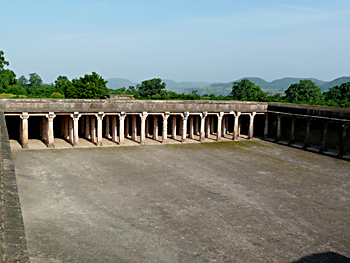 Religious monuments of Mandu comprise a number of mosques throughout the city. The mosques give a vivid representation of Islamic Architecture. But at some places even Hindu styles of architecture are also found in religious monuments of Mandu. Some of the notable religious monuments of the region include the Mosque of Dilawar Khan, the Jama Masjid and a few more.
Religious monuments of Mandu comprise a number of mosques throughout the city. The mosques give a vivid representation of Islamic Architecture. But at some places even Hindu styles of architecture are also found in religious monuments of Mandu. Some of the notable religious monuments of the region include the Mosque of Dilawar Khan, the Jama Masjid and a few more.
The mosque of Dilawar Khan is the earliest Islamic building at Mandu, comprising a central court enclosed by a colonnade, which are four aisles deep on the western side. There are also some Hindu elements in the main entrance, columns and ceiling and they are richly ornated.
At the south end of the square, which lies to the east, are the ruins of a balcony, the Nahar Jharoka or Tiger Balcony, has received such a name because the figure of a tiger once supported it. It is Mughal in origin and was used for public audience.
The Jama Masjid, begun by Hoshang Shah and completed by Mahmud I, is the most majestic building in Mandu. Reputedly modelled on the Great Mosque at Damascus, it is conceived in a monumental manner with a huge domed porch projecting from the eastern facade.
Flanking the porch the facade of the plinth forms a deep verandah with arched openings for cells. The doorway of the porch is beautifully ornamented with carved jari screens and bands of blue enamel tiles in the form of stars and lozenges. Beyond the west door is the Great Courtyard, faced on all sides by colonnades, to the west is the qibla wall, being the prayer hall, with fifty-eight small and three large domes. It is a well-disciplined, simple composition of considerable power. On the qibla wall there are seventeen niches. The central one has Quranic inscriptions. Along the north side are two subsidiary entrances, one for the priests, and the other for the zenana.
Mosque of Malik Mughis is a structure similar to that of Dilawar Khan, with a colonnaded central courtyard, a high plinth and widespread use of Hindu masonry. The plinth is arcaded with basement rooms; the central porch projects from the front with small corner pavilions. The dome over the porch has gone. The western colonnade of the courtyard has three small domes with flat or star-shaped compartments between. The west wall has mihrabs with blue tiles and bands of foliated patterns. To the front of the mosque is a caravansarai, an open court flanked by a pair of vaulted halls used for storage.
Religious monuments of Mandu are mainly mosques in various parts of the city and all the mosques of Mandu closely reflect the beauty of Islamic Architecture but at times it also shows confluence of both Hindu and Muslim styles of architecture.



















